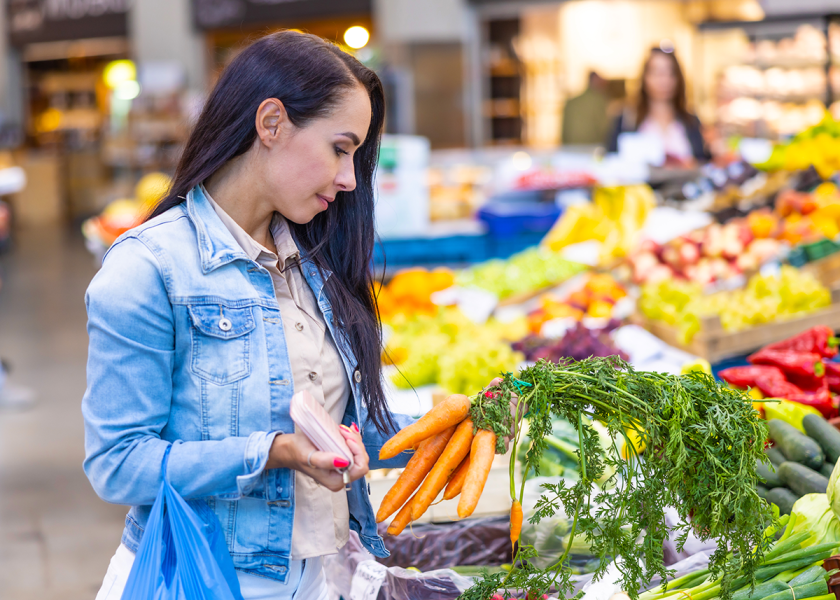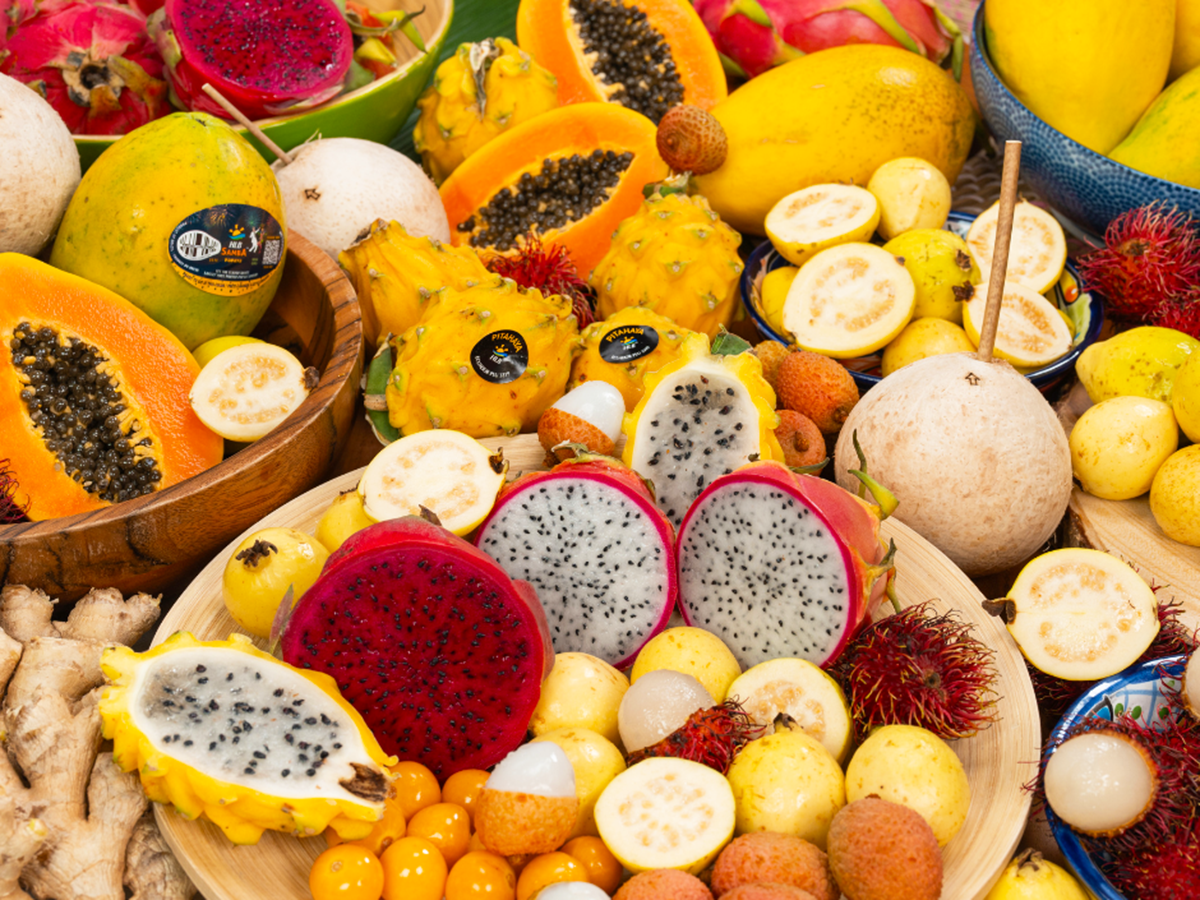Trending in retail: What shoppers want in the produce aisle

U.S. shoppers continue to drive diversity and innovation in the produce aisles of grocery stores. Top of mind are health and convenience for many people, but having fun and experimenting with new and unusual items are also key.
Today's consumers are looking for unusual produce to add excitement to their plates. Exotic fruits and vegetables are becoming better known, and Asian food in particular is becoming popular in the U.S., said Robert Schueller, spokesperson for Los Angeles-based Melissa’s Produce.
Frieda's Branded Produce, Anaheim, Calif., has a particular focus on Asian vegetables, such as purple sweet potatoes and chayote, so consumers can experiment "right in their own kitchens," said Alex Jackson, vice president of sales and procurement.
Consumers also are looking for color, says Robert Seegmiller, fresh produce sales director for Harmon's, a West Valley City, Utah-based grocery store chain. "This includes the growing popularity of brightly colored produce — like red, yellow and orange bell peppers and rainbow carrots — reflecting an interest in infusing diverse hues into dishes as individuals seek to elevate the visual experience in their meals."
In addition, busy shoppers want convenience with their produce. Shoppers at Hannaford Supermarkets, Scarborough, Maine, are looking for fresh-cut vegetables that make meal prep easier or healthy snacks that present new flavor combinations, like tahini on freshly cut fruit, says Mike Emery, director of produce merchandising.

Popular produce
Exotic produce saw increases in popularity last year. Papaya sales were up 12.5% and fresh coconut up 11% at retail in the 52 weeks ending Dec. 3, 2023, according to Circana OmniMarket Integrated Fresh, a Chicago-based market research firm.
When it comes to specific produce, dragon fruit is likely to be a standout in 2024. Melissa's offers three varieties (white, yellow, magenta), and HLB Specialties, Fort Lauderdale, Fla., is paying particular attention to the fruit since 2024 is the Year of the Dragon on the lunar calendar. The company has adapted its dragon fruit packaging to celebrate this, and Melissa Hartmann de Barros, director of communications, said the fruit resonates with both Asian and American consumers.
At 3 Guys from Brooklyn, a New York retailer where produce sales tend to focus on the basics of potatoes, plum tomatoes and avocados, dragon fruit is one of the unusual sellers, especially around Jewish holidays, says Philip Penta, managing partner.
"They are the most accessible of the exotics," with star fruit coming in second, he said. This is in part because the store can access dragon fruit at a good price and features it in a prominent display just inside the store's doors.
Both dragon fruit and passion fruit are popular, said Jackson of Frieda's. "These fruits are emerging as culinary sensations, offering a trendy twist on traditional fruit flavors."
And dragon fruit, said Adrian Capote, vice president of sales for J&C Tropicals, Doral, Fla., are becoming more available. "They continue to have the highest growth percentage year after year in the tropical category."
Guavas are also popular, said Hartmann de Barros, "and we see more and more retailers asking to carry this exotic fruit. Guavas combine a health aspect with their high vitamin C and fiber content, but also satisfy our desire for a tropical escape through foods with their floral flavor and aroma." And HLB Specialties' Brazilian samba papaya, which is very sweet, was the "breakout papaya star of 2023,"
she said.
They're part of a bigger trend "of an uptick in demand for exotics that haven’t yet been widely available in U.S. stores,” she said. “That is in part due to retailers pushing to bring new and undiscovered fruits to the market. It is also fueled by health trends and consumers looking to add healthier options to their diets while enjoying the flavors of the tropics."
Due to the demand for snacking produce, mini products like tomatoes and peppers are going to be popular heading into this year, according to Andrea Meloche, brand manager at Mastronardi Produce, Kingsville, Ontario.
"We have a very loyal following for our Sunset Bombs products, and we’ve added unique flavor profiles like our Umami Bombs to complement the lineup and give consumers even more choices from a brand they love,” Meloche said.
Also expected to sell well are Lollipeppers, mini peppers and Angel Sweet & Dip tomatoes, which come in a convenient package with a ranch dip.
Trend drivers
Social media is the hands-down winner when it comes to influencing consumers on which produce to eat, though traditional media (TV, radio, online, food sections) and restaurant chefs also play a part.
“Social media continues to have a strong stake in consumer decision-making as it relates to what they buy or eat,” Meloche said. “We see many food trends coming from platforms like TikTok which have created a lift in the market on certain items.”
But traditional recommendations are also a factor, said Seegmiller of Harmon’s.
"Word-of-mouth, garnered from trying these items at a friend's house or encountering them on shows like the Food Network or at restaurants, plays a pivotal role,” he said. “This firsthand experience often sparks a personal interest, prompting individuals to explore and integrate these trends into their own culinary adventures."
Retailers play a part too, Meloche added. "[They] certainly drive trends as they are our conduit for consumer feedback, letting us know what consumers want to see on store shelves."

Big picture trends
Other trends driving the consumption of produce in 2024 will be controlled environment agriculture and organic products.
Sales of organic produce have been increasing for Divine Flavor in recent years, said Michael DuPuis, spokesperson for the Nogales, Ariz.-based company.
"Part of this is due to a rise in younger generations such as Gen Z and millennials wanting to purchase produce that is grown and harvested more naturally,” he said.
At Hannaford Supermarkets, there's more interest and awareness in produce from controlled agriculture environments, such as greenhouse-grown tomatoes, Emery said.
"Supporting local producers is also very important to our customers and doing so will remain at the forefront of Hannaford’s produce program,” he said.
BrightFarms, Irvington, N.Y., has seen success with its indoor-grown salads and expects that to endure.
"As consumers continue to learn about the benefits of indoor grown, we expect them to try and stay within the subcategory," said spokesperson Jess Soare.
Packaging changes
The environment is front of mind when it comes to produce packaging, though packaging that offers convenience is still important and often trumps environmental concerns.
Schueller of Melissa's expects to see more recyclable packaging. HLB Specialties is "actively looking to convert our packaging to more sustainable options," said Hartmann de Barros. BrightFarms expects there to be more resealable packaging so consumers can keep product fresh.
Retailers also see packaging being more sustainably focused.
"The trajectory points towards a continued reduction in plastic usage, with a notable decrease in plastic lids," Seegmiller said. "Instead, there is a shift towards more sustainable packaging solutions, favoring overlays that reduce the overall reliance on plastic materials."
At Hannaford, "we expect suppliers to continue pursuing innovative alternatives to make packaging more sustainable," Emery said. "Retailers will be a part of those conversations as we introduce new packaging to customers while continuing to deliver the value, quality and exceptional experience they’re accustomed to when shopping for produce. The impact of climate change is becoming a larger factor in our customers’ decision-making when shopping for produce, especially amongst younger generations."
Divine Flavor continues to look for better options for packaging, DuPuis said.
"However, there are some barriers to overcome: cost, quality and shelf life, recyclable availability in certain regions. We need to come together as an industry and fully understand it from all sides of the supply chain."
Jackson of Frieda's expects that packaging will continue to become more interactive and informative, enhancing the consumer experience, with QR codes providing information about the product and its origin, along with recipes and usage tips.
"This tech-savvy approach ensures consumers are well-informed and engaged when selecting our produce," Jackson said.
Boosting sales
Multiple factors are involved in selling produce, and that's expected to be no different in 2024. Social media is huge, especially in educating consumers on what to do with produce that's isn’t widely known, said Hartmann de Barros. "We are creating more content on how to enjoy our fruits, and hopefully that will drive more sales."
But stores are an important place for boosting sales, and shelf strips and informational signage are key, said Schueller, especially when merchandising is given a bump for special events like the Super Bowl or holidays like Valentine's Day.
"Merchandising the produce in stores, especially when they're at their freshest and in season, tends to grab people's attention and makes them more likely to buy," Seegmiller said. "It's a simple but effective way to encourage sales."
HLB Specialties is also a fan of store demos, "and we try to take advantage whenever possible," said Hartmann de Barros. "We know they translate into higher sales, but we are also aware of the costs associated with demos."







